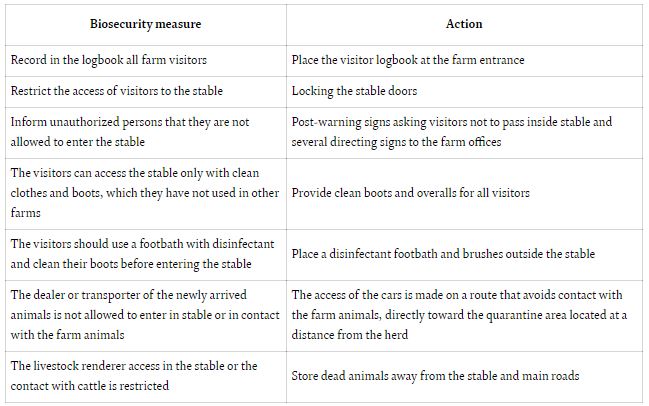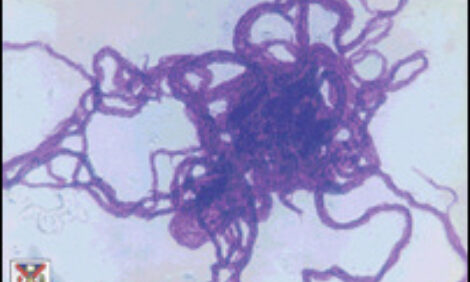



Dairy Farms Biosecurity: Protecting against Infectious Diseases and Antibiotics Overuse
Biosecurity is a key element in the battle against antibiotic resistance. The goals of biosecurity are focused not only on the reduction or prevention of the introduction of new diseases from outside sources but also on the reduction or prevention of the movement of infectious diseases on the farm.In this regard, the use of antibiotics can be reduced by simple actions such as physically inspecting animals, testing for bovine diseases, vaccination, or quarantine for at least 3 weeks before mixing with the herd of all new additions. All these examples reduce the risk of diseases with germs from outside.
This chapter attempts to synthesize the best biosecurity solutions that can be applied in modern dairy farms, writes authors Stelian Baraitareanu and Livia Vidu, professors at the University of Agronomic Sciences and Veterinary Medicine of Bucharest.
1. Introduction
In dairy farms, biosecurity, surveillance, resilience/immunity, biocontainment, and control of disease spread within the herd are the pillars that need to be appropriately managed to ensure the healthy herd [1].
Biosecurity is focused to reduce and prevent the introduction of diseases or pests of animals on a farm, and to minimize the spread of diseases or pests within a farm. Biosecurity action plans need to be implemented mainly in large dairy farms where the disease agents can be introduced by various sources such as labor, advisers, replacement cattle, supplies, feedstuffs, and vehicles [2].
Surveillance programs are developed for early detection of emerging pathogens, to establish disease-free status or the prevalence of a specific disease in a herd [3].
Relation resilience immunity is based on the individuals’ resistance to diseases that can be modulated by the ability of animals to adapt to adverse conditions (stress factor) and recover from them [4].
Biocontainment and control programs are important backup systems for biosecurity plans that will prevent the emerging disease spreading within the herd or the endemic diseases spreading between animals into the farm [2, 5].
The overall biosecurity of dairy farm uses different levels or shells of actions (national or supranational, regional, and local), linked with the epidemiological profile of the pathogen. For highly contagious infectious agent (e.g., foot-and-mouth disease), the most efficient biosecurity plan is at national or European Union level, while for infectious agents transmitted by close contact between animals (e.g., bovine tuberculosis), the regional biosecurity measures such as movement controls will protect the status of the region [1].
Biosecurity practices on livestock farms have been described and prioritized in various ways [1, 2, 5, 6]. In this chapter, we grouped biosecurity measures in the following categories: dairy farm sanitation, facility biosecurity, animal biosecurity, feed biosecurity, and manure biosecurity.
2. Dairy farm sanitation
2.1 Employees and visitors
Some infectious agents are specific for dairy cattle and others are zoonotic, affecting both bovine and human health. Employees and visitors can contribute to the spread of all these infectious agents on a dairy farm [7]. The transmission of pathogens by humans can be reduced or even stopped by providing on-farm laundry facilities for all protective clothing used on the farm, using only clean overalls during farm visits, providing disposable clean booties for visitors and cleaning of boots with disinfecting solution after scrubbing off any visible dirt at the end of the visit, and washing of hands before and after working with sick or young animals [7, 8, 9].
Milking parlor personnel should wear latex gloves while milking to reduce the spreading potential of the contagious mastitis pathogens [9]. Sometimes, these hired personnel can take care of other animals outside the dairy farm and carry pathogens on the farm. Employees should be regularly trained in good practices to prevent the spread of disease (the principles of hygiene and disease security). They need to know that calves are susceptible to diseases carried by adult animals, and daily activities should be organized so that employees work with younger animals before working with older animals. Prevention of the infectious agent’s introduction and spreading from outside and inside sources should also be considered in the education of hired personnel in basic hygiene and disinfection [10]. The main actions included in the biosecurity plan for dairy farms should reduce the risk of infectious diseases to be introduced by employees and visitors (Table 1).
Biosecurity measures designed to reduce the risk of the infectious disease’s introduction in dairy farms by employees and visitors.
The access of visitors must be limited and recorded in a logbook; the farm touring must start from younger to older animal groups; barn doors are recommended to be locked and a warning sign must be posted to keep out unauthorized personnel [9].
Also, along the access road of the farm must be displayed signs directing visitors to the administrative area and to the visitor parking, as well as warning signs to limit direct contact of visitors with farm feed and animals [11].
2.2 Equipment biosecurity
Equipment can be contaminated with infectious secretions, excretions, and blood and the movement of equipment between stalls and farms may also transport pathogens [12].
All equipment used on the farm must be regularly cleaned and disinfected [11]. To prevent contamination of equipment, storage containers need to be used for all tools and feeding equipment. Also, all storage containers are regularly cleaned and disinfected. The storage containers must protect equipment from diseases, pests, or weeds [13]. Before use in healthy animals, equipment that has been used on sick animals must be cleaned and disinfected. However, it is better not to use clothing, shoes, and tools dedicated to the compartment of sick animals [14]. Dehorners, ear taggers, hoof knives, clippers, and all shared and hired equipment will be cleaned and disinfected between uses [11, 14].
Nursing bottles and buckets must be sanitized before each feeding [14], calves kept indoors must have fresh clean dry bedding, and plastic calf hutches will be cleaned and disinfected after use [11].
The equipment used for manure disposal will not be used for transporting or delivering feed [13].
Disposable clothing and used veterinary equipment must be removed safely [11].
2.3 Vehicle biosecurity
Vehicles are considered fomites mainly for pathogenic robust organisms that can survive a long time in the environment [1]. Mainly external vehicles that collect milk, calves, and carcasses or deliver feedstuffs, pharmaceuticals, and semen can be involved in the transmission of infectious disease because they travel daily from farm to farm [2, 10]. A high biosecurity risk is associated with carcasses (dead stock) collectors because they are usually in contact with diseased animals [15, 16].
To prevent the introduction of infectious agents, vehicles must be kept clean and should not have access to the zones where the animals are housed [10, 11, 17].
External vehicles should not be allowed on the farm [18]. If vehicles are necessary on the farm, then ensure that vehicles and trailers are clean when entering the farm and disinfected before and after use [6, 11, 18, 19]. Cleaning and disinfection will cover both the exterior and the interior of the vehicles, with greater attention to areas where dirt may be hidden (e.g., wheel arches and tires) [11]. Because the transport by dealers may pose additional risks of infectious disease transmission between farms, it is recommended that the animal moving will use only farm-owned vehicles [20], with clean and ample bedding to prevent both injuries and disease [14].
Guidance indicators and warning and restricting access signs to unauthorized vehicles must be placed at the entrance to the farm road and along the road. The farm must have a designated area for visitors’ vehicles that are at the entrance of the farm and away from the animal and animal stalls [6, 10, 14]. Also, service vehicles should not drive over the routes of feed delivery or manure handling [14].
3. Buildings biosecurity
In a dairy farm, the building’s design can help prevent the spread of pathogens to sick cows, periparturient cows, and newborns [2]. Buildings should have a well-established destination, in correlation with the categories of animals present on the farm. Dairy farms can secure their premises against domestic and wild animals by installing various types of fences (e.g., electric fence) around the buildings. Disinfectant footbaths should be at the entry of livestock housing.
All farms should have isolation building (the quarantine facility) where the health status of the newly purchased cows will be observed before they join the rest of the herd [21]. To prevent direct and indirect contact between residents and new animals, the quarantine facility should be located in the farthest possible place on the dairy farm [10].
The farm must have a biosecurity plan that includes building maintenance activities (e.g., check and maintain fences, replace bird netting, and repair holes in buildings), which will reduce the contact of cattle with wild animals and the feed contamination with birds droppings or badger feces [14, 21].
Baraitareanu , Stelian, and Livia Vidu. “Dairy Farms Biosecurity to Protect against Infectious Diseases and Antibiotics Overuse.” IntechOpen, 8 July 2020, www.intechopen.com/books/antimicrobial-resistance-a-one-health-perspective/dairy-farms-biosecurity-to-protect-against-infectious-diseases-and-antibiotics-overuse.



